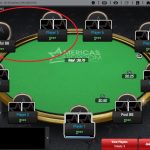
Contents
- Hand Analysis – Opponent Has 20 Big Blinds
- Calculating the Expected Value of Raising and Calling All-In
- Calculating the Expected Value of Pushing All-In
- Calculating the Expected Value of Raising and Folding
- Calculating the Expected Value Against a Tight-Passive Opponent
- Optimal Play Based on Your Opponent
- Leave a Review
Eric “Rizen” Lynch provides a hand analysis below.
A few months ago, I wrote an article about how some players are misapplying expected value calculations. The column focused on a particular play of shoving a wide range of hands when playing heads up with 20 big blinds. If you do the math, you discover that pushing all in is perfect strategically: You could play with your hand faceup and it would still be profitable. That column discussed several different factors that you should consider, but one key factor is that just because a play is profitable, it doesn’t mean you should make it. You should be making the most profitable play.
I was reviewing a book Winning Poker Tournaments One Hand at a Time, Volume II. The book has three authors — Jon “PearlJammer” Turner, Eric “Rizen” Lynch, and Jon “Apestyles” Van Fleet. Each author walks through the key hands of a tournament that he played, from the bubble through heads-up play.
One of the hands from Rizen illustrates that the optimal play depends on the particular opponent you are facing, and it makes for a great follow-up to the column I wrote.
Hand Analysis – Opponent Has 20 Big Blinds
Here’s the hand, described by Rizen:
Hand 16
Seat 2, small blind: 37,886 (Rizen)
Seat 3, big blind: 48,159
1,200-2,400 blinds, 300 ante
Setup: I have just been moved to a new table, and we are seven-handed. I have no significant reads on the table, except that the player to my immediate left is a very good player who plays a push/fold game. He almost never takes flops, and loves to resteal all in with almost reckless abandon. This is the third hand at my new table, and I have a little more than 15 big blinds.
Preflop (5,700) Q J
J : The action is folded to me. My read on the player in the big blind indicates that he will probably shove over a standard raise with a super-wide range of hands. Q-J might be slightly ahead of that range, but not enough to encourage that sort of action. My stack may be a bit larger than your normal push/fold stack to push all in, but my opponent will be forced to fold many hands that he would probably three-bet. This gets some hands like K-7, which are slightly ahead of me, to fold, as well as some hands that I am only a slight favorite against, like 10-9 suited.
: The action is folded to me. My read on the player in the big blind indicates that he will probably shove over a standard raise with a super-wide range of hands. Q-J might be slightly ahead of that range, but not enough to encourage that sort of action. My stack may be a bit larger than your normal push/fold stack to push all in, but my opponent will be forced to fold many hands that he would probably three-bet. This gets some hands like K-7, which are slightly ahead of me, to fold, as well as some hands that I am only a slight favorite against, like 10-9 suited.
However, he will still call me with a very wide range. He is probably not going to fold any hand that is ahead of me, except for some weak A-X and K-X hands. If I were to make a standard raise, he would reraise all in anyway with all of the hands with which he would call an all-in push. Going all in is actually a lower-variance play than raise/calling. By pushing, I avoid some marginal all-in situations compared to the raise/call strategy, and I add more than 11 percent to my stack when my opponent folds.
I push all in for 37,586, and the big blind folds.
Calculating the Expected Value of Raising and Calling All-In
Showing this mathematically, if I were to make a standard raise and call an all-in reraise based on my read that he was reraising with a very wide range (for example, 2-2+, A-2+ suited, K-2+ suited, Q-8+ suited, J-8+ suited, 10-8+ suited, 9-7+ suited, 8-6+ suited, 7-6 suited, 6-5 suited, A-2+ offsuit, K-5+ offsuit, Q-10+ offsuit, J-10+ offsuit, and 10-9 offsuit), it totals 39.1 percent of hands. So, 60.9 percent of the time, I would win the blinds and antes, and the other 39.1 percent of the time, I would have 44.5 percent equity in the pot:
(.609) 5,700 + (.391) [(.445) (39,386) – (.555) (36,286)]
3,471 + (.391) (17,527 – 20,139)
3,471 + (.391) (-2,612)
3,471 – 1,021
EV [Expected Value] = 2,450
Note that I will also be out of the tournament 21.7 percent of the time this way (39.1 percent of 55.5 percent).
Calculating the Expected Value of Pushing All-In
The second option is pushing, assuming that my opponent will call an all-in bet with a tighter range than he would three-bet with: 4-4+, A-2+ suited, K-8+ suited, Q-10+ suited, J-10 suited, A-7+ offsuit, K-10+ offsuit, Q-10+ offsuit, and J-10 offsuit (22.8 percent of hands). By pushing, my expected value increases, as I will win the blinds and antes 77.2 percent of the time and have 40.7 percent equity when he calls:
(.772) 5,700 + (.228) [(.407) (39,386) – (.593) (36,286)]
4,400 + (.228) (16,030 – 21,518)
4,400 + (.228) (-5,488)
4,400 – 1,251
EV [Expected Value] = 3,149
Pushing not only shows a higher profit, but also results in being knocked out of the tournament only 13.5 percent of the time (22.8 percent of 59.3 percent).
Calculating the Expected Value of Raising and Folding
There is a third option, raise/folding, which is similar to the first scenario, but I lose just my raise amount (approximately three times the big blind minus the posted small blind, so 2.5 times the big blind, or 6,000):
(.609) 5,700 + (.391) (-6,000)
3,471 – 2,346
EV [Expected Value] = 1,125
Although this play has positive expectation, it is by far the lowest-expectation option against this player, but it does result in never being eliminated.
Calculating the Expected Value Against a Tight-Passive Opponent
By contrast, I’m going to show how the results would change if the big blind were a more tight-passive player who would reraise all in with the same range with which he would call (that is, never resteal). The range I’m using for this player is 7-7+, A-10+ suited, K-10+ suited, Q-J suited, A-10+ offsuit, K-J+ offsuit, and Q-J offsuit (12.4 percent of hands).
Since his range is the same for both the first scenario (in which he goes all in over the raise and I call) and the second scenario (in which I push all in), I can use the same calculations for both. This works only because his range for pushing and for calling are identical. When all in, my equity is 33.2 percent against his range.
(.876) 5,700 + (.124) [(.332) (39,386) – (.668) (36,286)]
4,993 + (.124) (13,076 – 24,239)
4,993 + (.124) (-11,163)
4,993 – 1,384
EV [Expected Value] = 3,609
Against this player, I would be out of the tournament 8.2 percent of the time (12.4 percent of 66.8 percent). I have good expected value here, but raising three times the big blind and then folding to this player has even better expected value:
(.876) 5,700 + (.124) (-6,000)
4,993 – 744
EV [Expected Value] = 4,249
This option provides better expected value and also no chance of elimination.
Optimal Play Based on Your Opponent
There are several important conclusions to make from this sort of analysis: The first is that against hyper-aggressive players who are willing to push with a very wide range, it can often be more profitable, with lower variance, to just take the play away from them by pushing all in yourself, rather than give them the chance to push over your raise in a situation where you have less than 20 big blinds. Second, against tighter, uncreative players who are going to play more straightforwardly, raising and folding if they push all in can be better than just pushing all in. When choosing the optimal play, it’s very important to have an idea of how aggressive your opponent is and how he might react.
Rizen’s hand analysis clearly demonstrates the mathematics behind this play. More importantly, he explains that pushing is sometimes the best play, while raising and folding can also be the best play. Avoid playing robotic poker, and make sure that you are exploiting the play of the specific opponent you are facing.
Leave a Review
Submit your review | |







